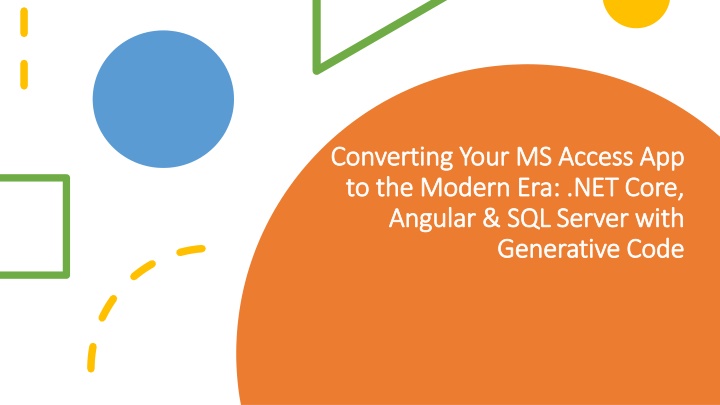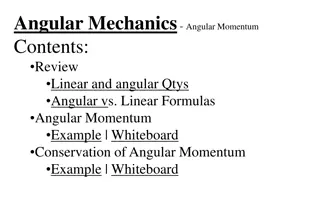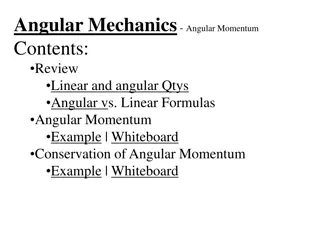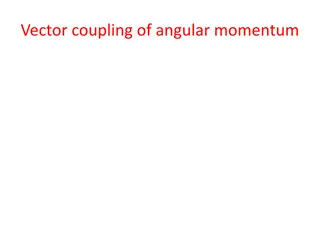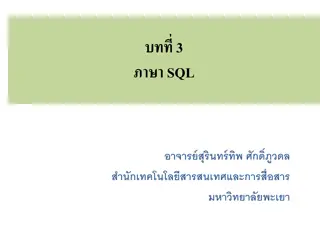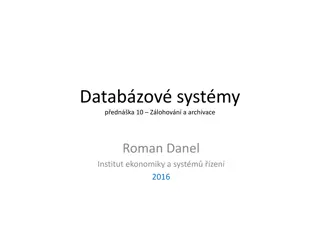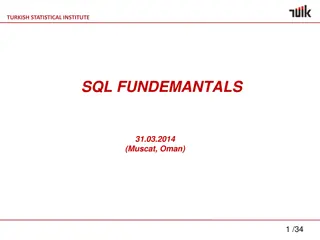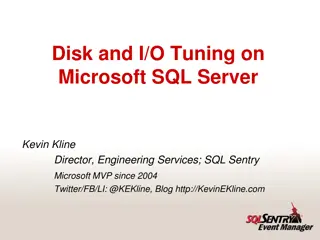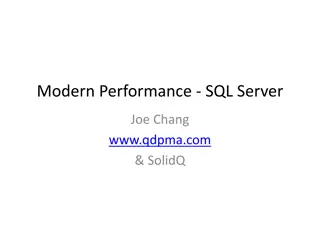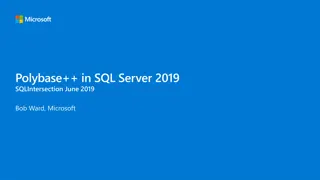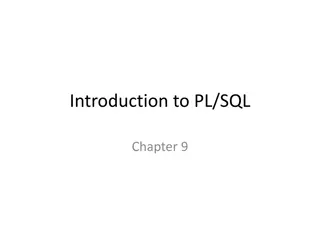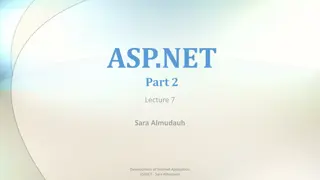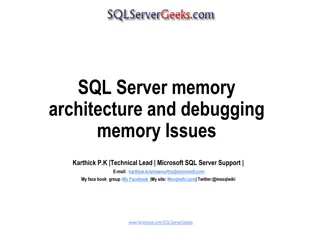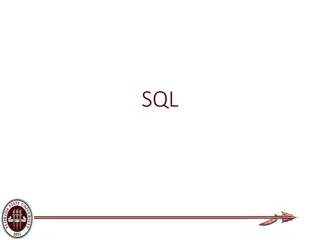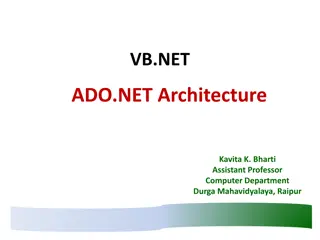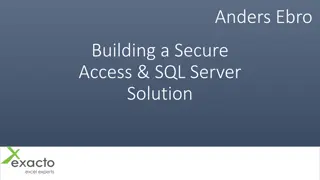Modernize Your MS Access App with .NET Core, Angular & SQL Server
In today's world, businesses require agile and scalable applications. This presentation explores how generative code can streamline the conversion process of your MS Access app to a powerful .NET Core, Angular, and SQL Server stack. Discover the limitations of MS Access and the benefits of a modernized application architecture. Learn about automating repetitive tasks, reducing development time, and modernizing with .NET Core, Angular, and SQL Server for improved maintenance, security, and user experience.
Download Presentation

Please find below an Image/Link to download the presentation.
The content on the website is provided AS IS for your information and personal use only. It may not be sold, licensed, or shared on other websites without obtaining consent from the author.If you encounter any issues during the download, it is possible that the publisher has removed the file from their server.
You are allowed to download the files provided on this website for personal or commercial use, subject to the condition that they are used lawfully. All files are the property of their respective owners.
The content on the website is provided AS IS for your information and personal use only. It may not be sold, licensed, or shared on other websites without obtaining consent from the author.
E N D
Presentation Transcript
Converting Your MS Access App Converting Your MS Access App to the Modern Era: .NET Core, to the Modern Era: .NET Core, Angular & SQL Server with Angular & SQL Server with Generative Code Generative Code
Stuck in the Stuck in the Past? Past? Modernize Modernize Your MS Your MS Access App Access App In today's world, businesses need agile and scalable applications. While MS Access served us well, it's time to consider a modern upgrade. This presentation explores how generative code can streamline the conversion process to a powerful .NET Core, Angular, and SQL Server stack.
The Current Problem: Limitations of MS Access The Current Problem: Limitations of MS Access Limited scalability: MS Access struggles with large datasets and complex functionalities. Desktop-bound: Access applications are not readily accessible on mobile devices. Security concerns: Access offers limited built-in security features for robust data protection. Maintenance challenges: Finding developers familiar with legacy Access can be difficult.
The Ideal Solution: A Modernized Application Architecture The Ideal Solution: A Modernized Application Architecture Three-tier architecture: Separates presentation, business logic, and data access for modularity. Scalable database: SQL Server offers robust performance and scalability for large datasets. Dynamic frontend: Angular allows for building responsive and interactive user interfaces. Secure backend: .NET Core provides a secure foundation for building APIs.
Generative Generative Code: Your Code: Your Conversion Conversion 01 02 03 Automates repetitive tasks: Generative code can create boilerplate code for data access and basic functionalities. Reduces development time: Streamlines the initial conversion process. Not a magic bullet: Requires manual intervention for complex logic and UI development. Ally Ally Modernizing with .NET Core, Angular, and SQL Server provides a robust and scalable architecture. This separation of concerns allows for easier maintenance, improved security, and a user- friendly, web-based experience.
The Conversion The Conversion Process: A Process: A Step Step- -by by- -Step 1 2 3 4 5 Step Guide Guide Auto Analyze the existing Access application: Understand data model, forms, reports, and VBA code (if any). Design the new architecture: Define database schema, backend API using .NET Core and Entity Framework, and frontend components in Angular. Utilize generative code tools: Migrate database schema and generate basic CRUD operations for data access. Manual development: Define custom templates for the complex code. Testing and deployment: Rigorously test the application and deploy it to a suitable hosting environment. A successful conversion is a step-by-step process. By thoroughly analyzing the existing application and meticulously designing the new architecture, generative code can be leveraged to automate initial code generation. However, manual template development remains crucial for complex functionalities and user experience.
Analyzing the Analyzing the Existing Access Existing Access Application Application using AI using AI 1 2 3 Identify tables, relationships, fields, and data types in the Access database. Map user interactions in Access forms and reports to functionalities and data access patterns. Extract business logic from VBA code (if any) to be implemented in the new backend. A thorough understanding of the existing application is paramount. This involves meticulously examining the database structure, user interactions, and any underlying business logic to ensure they are accurately translated into the new architecture.
Design the New Architecture Design the New Architecture - - Database (SQL Server) Database (SQL Server) SQL Server provides a robust and scalable foundation for the new application's data storage. Utilize migration tools or generative code to efficiently convert the data schema from Access. Ensure proper data relationships are established using primary and foreign keys for data integrity. Consider data normalization techniques to optimize storage and minimize redundancy. MIGRATE DATA SCHEMA FROM ACCESS TO SQL SERVER USING TOOLS OR GENERATIVE CODE. DEFINE PRIMARY AND FOREIGN KEYS FOR DATA INTEGRITY AND RELATIONSHIPS. CONSIDER DATA NORMALIZATION FOR OPTIMAL STORAGE AND PERFORMANCE.
Design the New Architecture Design the New Architecture - - Backend (.NET Core) Core) Backend (.NET 1 2 3 4 Auto generate controllers for handling API requests from the Angular frontend. Utilize Entity Framework Core to interact with the SQL Server database. Implement business logic extracted from Access VBA or define new logic as needed. Leverage dependency injection for loose coupling and testability. The .NET Core backend serves as the engine of the application. Define controllers to handle incoming API requests from the Angular frontend. Entity Framework Core simplifies data access to the SQL Server database. Implement the previously extracted business logic or develop new logic as required. Utilize dependency injection for a modular and maintainable codebase.
Design the New Architecture Design the New Architecture - - Frontend (Angular) Frontend (Angular) The .NET Core backend serves as the engine of the application. Define controllers to handle incoming API requests from the Angular frontend. Entity Framework Core simplifies data access to the SQL Server database. Implement the previously extracted business logic or develop new logic as required. Utilize dependency injection for a modular and maintainable codebase. DESIGN REUSABLE ANGULAR COMPONENTS TO REPRESENT FORMS AND REPORTS FROM THE ACCESS APPLICATION. GENERATE ANGULAR SERVICES TO INTERACT WITH THE BACKEND API FOR DATA RETRIEVAL AND MANIPULATION. IMPLEMENT USER INTERFACE FUNCTIONALITIES AND USER INTERACTIONS FOR A SEAMLESS USER EXPERIENCE. AUTO GENERATE RESPONSIVE DESIGN PRINCIPLES FOR A MOBILE-FRIENDLY APPLICATION.
Showcase examples of how generative code can automate tasks: Generating basic CRUD operations (Create, Read, Update, Delete) for data access. Automating database schema migration from Access to SQL Server. Auto generate Angular frontend app based on MS-access forms. Auto generated Angular frontend component for the MS-access reports. Generative Generative Code Tools in Code Tools in Action Action Provide concrete examples of how generative code can streamline the conversion process. Demonstrate how it can automatically generate basic functionalities like CRUD operations for interacting with the database, or how it can translate the schema definitions from Access to SQL Server.
Benefits of Modernization Benefits of Modernization Improved scalability: The new architecture can handle larger datasets and increased user traffic. Enhanced security: .NET Core provides a robust foundation for secure API development. Increased accessibility: The web-based application can be accessed from any device with an internet connection. Easier maintenance: A modern codebase attracts a wider pool of developers for future maintenance. Modernizing your application with .NET Core, Angular, and SQL Server unlocks a plethora of benefits. The new architecture allows for effortless scaling to accommodate future growth. Enhanced security features ensure data protection. Web accessibility allows users to access the application from anywhere. Finally, a modern codebase makes it easier to find developers for future maintenance and updates.
